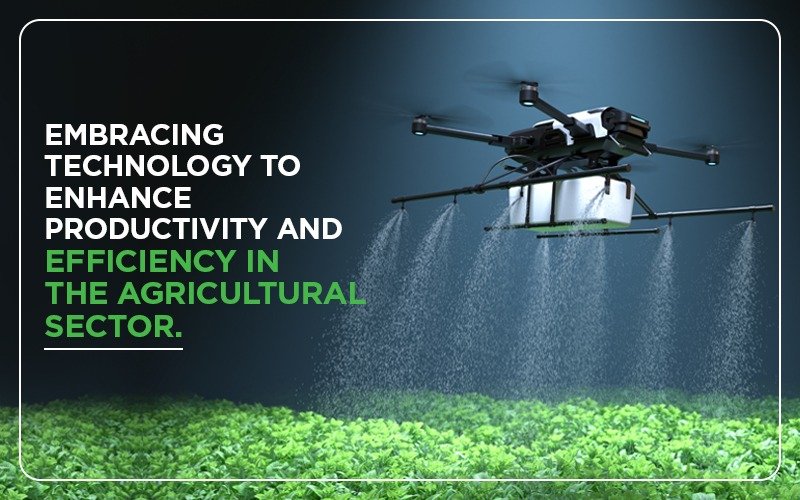
Embracing technology to enhance productivity and efficiency in the agricultural sector
Posted on January 17, 2024
In this advanced world, there is high demand for increased productivity and sustainable practices. When we look at the vast field of agriculture, these demands are surging and technology provides the required support to the sector.
In simpler words, technology is embraced by the agricultural sector to enhance productivity and efficiency. The cutting edge technology utilized here ranges from precision agriculture to agricultural robots. It is integrating machine learning to the Internet of Things (IoT). Thus, it can be seen that technological advancements are actively assisting to achieve goals.
The digital wave is reshaping farming practices. This practice is promoting an era of smart, efficient, and sustainable agriculture. Let’s delve deeper to see how it is working.
Precision Agriculture: The Art of Targeted Farming
The agricultural revolution that is going on is based on precision agriculture, forming its core. Precision agriculture is nothing but a paradigm that leverages technology to optimize crop yields while minimizing the waste. This incorporates Machine learning and artificial intelligence (AI) algorithms. These technologies process vast amounts of data, ranging from soil composition to weather patterns. This data-driven approach allows farmers to make informed decisions. In addition it lets farmers strategically plan planting, irrigation, and fertilization, ensuring resources are used efficiently.
Digital Agriculture Unleashed: Internet of Things (IoT) and Sensors
Traditional farming is transforming into smart farming. The Internet of Things (IoT) has integrated into agriculture seamlessly and interconnected respective ecosystems. Technological approach here is data driven. For this real-time data collection on soil moisture, temperature, and crop health, sensors are placed in the field. This ensures a continuous stream of information. Eventually, it empowers farmers with actionable insights, enabling them to monitor and manage their crops with unprecedented precision.
Computer Vision and Remote Sensing: Eyes in the Sky for Smart Farming
Computer vision in agriculture, coupled with remote sensing technologies, provides a literal bird’s-eye view of fields. This can be understood as Drones equipped with high-resolution cameras capture the images that are then analyzed through deep learning algorithms. This visual data helps identify crop health, detect diseases, and assess overall field conditions. Consequently we get monitoring and analysis of a level that surpasses human capabilities. This fosters more efficient decision-making.
Decision Support Systems: Smart Management in Every Aspect
In agricultural management, strategic decision making is essential. These decision support systems are powered by AI and are becoming invaluable tools. These systems integrate data from various sources, including weather forecasts, soil conditions, and market trends, to provide farmers with tailored recommendations. From planting schedules to pest control strategies, these intelligent systems guide farmers through every stage, optimizing outcomes and minimizing risks. In addition, these help in optimizing outcomes and minimizing risks.
Automation Revolutionizing Irrigation and Farm Operations
Automation has penetrated deep into the heart of farming operations. This brings efficiency and precision to tasks that were once labor-intensive. Automated irrigation systems, guided by real-time data, ensure that crops receive the optimal amount of water. This results in minimizing waste and maximizing yield. The integration of robotics in agriculture takes automation much further.
Agricultural Robots: The Workforce of the Future
Agricultural robots are emerging as game-changers in farming. These reduce the dependency on manual labor. Thus this addresses challenges related to labor shortages. These robots are designed to carry out specific tasks. These tasks may range from precision planting to selective weeding. These are designed to carry out operations with accuracy and efficiency. The result of utilizing these is not only increased productivity but also a more sustainable and resource-efficient approach to farming.
Sustainable Agriculture Through Innovation: Challenges and Opportunities
While the integration of technology brings forth a wave of opportunities, it also presents challenges that demand thoughtful consideration. There are issues that needs to be addressed. Issues such as data security, accessibility for small-scale farmers, and the environmental impact of technology adoption require careful navigation. However, the potential benefits paint a promising picture for the future of agriculture. These benefits are in terms of resource optimization, reduced environmental impact, and increased global food production.
Towards a Sustainable Future: Balancing Innovation and Responsibility
Today, Agriculture is undergoing a digital transformation. With this transformation, it becomes a responsibility to embrace innovation. But you also need to ensure that these technologies are contributing to a sustainable agricultural future. It is very important that you strike a balance between increased productivity and environmental conservation. This will make technology a positive chance rather than a potential risk to the environment.
Conclusion:
In conclusion we can say that in the embrace of technology and innovation, agriculture is undergoing a profound transformation. The sector is evolving into a smarter, more efficient, and sustainable industry.
You can see that the digital wave is reshaping every aspect of farming. Be it precision agriculture driven by machine learning or the automation revolution led by agricultural robots. As we observe this path of innovation, the promise of feeding a growing global population while minimizing environmental impact can be fulfilled. The seeds of tomorrow’s agriculture are sown in the fields of today, where technology acts as the catalyst for a flourishing future.
